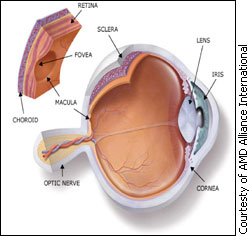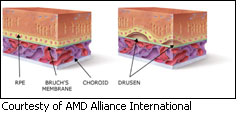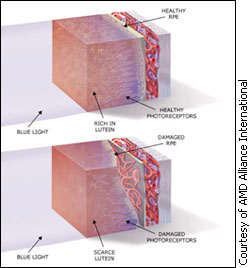
|
|
Age-related macular degeneration is a degenerative eye disease that afflicts many Canadians. Fortunately, studies now show that regular consumption of certain antioxidants can reduce your risk of developing macular degeneration or slow the disease's progression. The eye works like a camera. Rays of light pass through the cornea and into the pupil. The lens directs the light to the back of the eye, which is lined with the retina. Photoreceptor nerve cells on the retina then transform the light into electrical impulses which travel through the optic nerve to the brain. The macula is the small, centre portion of the retina affected by macular degeneration.
Wet and dry There are two types of macular degeneration: wet and dry. All cases of macular degeneration begin as the dry form, but some cases evolve into the wet form. Joanne Matsubara is an expert on age-related macular degeneration from the University of British Columbia. She says the wet form is less common but much more aggressive and can quickly lead to central vision loss. “It is called ‘wet’ because there are abnormal blood vessels behind the retina that grow quickly and can leak blood and fluid,” says Matsubara. “The blood and fluid cause photoreceptors to die and thus causes vision loss.” The dry form is more common. Ottawa optometrist Dr. Thomas Noel says that with this form protein deposits called drusen form layers in the retina and cause central vision to slowly decrease. “When the retina has too many drusen there is not enough oxygen getting to the retina,” says Noel. “Membranes underneath the retina form new blood vessels to bring more oxygen to the retina. If these membranes form on top of the retina it hides the film and you lose your vision.”
Antioxidants: Where do they fit in? It is with the dry form that certain antioxidants may prove beneficial in preventing or treating the disease. Jay Kalra is a professor of pathology at the University of Saskatchewan. He is an expert on antioxidants and oxidative damage. He says that too many free radicals in the body can lead to medical problems such as liver damage and heart failure. There is no way to completely eliminate free radicals from our system, but several lifestyle choices such as poor diet and exposure to pollution and cigarette smoke can increase the number of free radicals in our bodies Kalra describes the interaction between free radicals and antioxidants as a system. “Our body has an antioxidant system. There needs to be a balance to manage the formation of free radicals,” says Kalra. “The damage is going to occur when there is more production of free radicals and less destruction of them by antioxidants.” Antioxidants can be found naturally in many fruits and vegetables. Some commonly known antioxidants are carotene, iron, zinc, and vitamins A, C and E. Lutein and zeaxanthin: Can they help? Jie Jin Wang and several other Australian researchers, published a study early this year in the American journal Opthalmology about dietary antioxidants and the long-term incidence of age-related macular degeneration. “We observed an association between intake of lutein and zeaxanthin and reduced prevalence or incidence of age-related macular degeneration,” says Wang. Previous studies have suggested that certain antioxidant supplements may slow the disease's progression. “Our research suggests that antioxidants derived from the diet and low-dose supplements may also be protective,” says Wang. “Amounts which were protective in our study were dietary intakes above 15.8 mg of zinc and above 948 mg of lutein and zeaxanthin.”
Wang says that it is not known for sure why consumption of these two antioxidants seem to reduce a person’s risk of macular degeneration, but there are several theories. The macula itself contains lutein and zeaxanthin in fairly high concentrations. Also, these two antioxidants increase membrane stability and blue light absorption. Although lutein and zeaxanthin may help lower your risk of macular degeneration or slow the disease's progression, Wang does not believe that macular degeneration can be entirely prevented by antioxidant consumption. “Age-related macular degeneration is a complex disease not caused entirely by a single factor, so it would not be entirely preventable by any single factor,” says Wang. “However, eliminating any risk factors for age-related macular degeneration may help to reduce the risk of the disease.”
|
|
|


